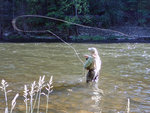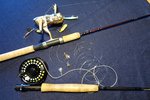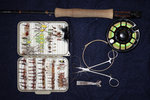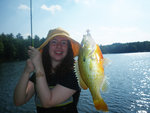So, you always thought, “Fly fishing looks like fun. I’d like to try it, but it sounds like it’s too hard,” or “Fly fishing sounds great, but I can’t afford …
Stay informed about your community and support local independent journalism.
Subscribe to The River Reporter today. click here
This item is available in full to subscribers.
Please log in to continue |




So, you always thought, “Fly fishing looks like fun. I’d like to try it, but it sounds like it’s too hard,” or “Fly fishing sounds great, but I can’t afford it.” We are here to tell you that these are fly fishing myths.
Myth number one: Fly fishing is hard to do.
As retired Delaware River fly fishing guides, we have taught many novices the basics of fly fishing in a single afternoon. In many ways, golf provides a very nice analogy for fly fishing. While it is true that it would be terribly difficult to compete with Tiger Woods on a golf course, millions of people go out on a golf course, shoot in the 90s and have a great time. If you want to get started but don’t want to engage a guide or instructor to coach you for an afternoon, you can try looking at one of the instructional videos on YouTube (see sidebar on page 17 for suggested links).
So it’s the same with fly fishing as with golf. You can grab a fly rod and get out to a local fishing spot and have a blast. You may not have the casting stroke or accuracy of a fishing Tiger Woods, but you still are out having a wonderful time on the water and maybe even catching a fish or two. And although fly fishing for trout is probably your goal, it’s not a bad idea to start out fly fishing for sunfish. You can do this on any farm pond, and sunfish are a lot less finicky than trout. You can catch them with almost any fly, and with a short cast of, say, 20 feet.
Myth number two: Fly fishing is expensive.
So, conventional wisdom to the contrary, fly fishing is not necessarily hard to do. As with any sport, it is easy to start and enjoy, even though it may be difficult to perfect. Now you may say “Well, OK, I’m convinced that I might be able to do it; but the equipment is so expensive, and I have to travel so far to find good fly fishing.”
First, let’s take a look at the equipment. Most people try fly fishing after having been a spin fisherman first. You may have learned to fish casting a Zebco rod and reel and catching panfish. We suggest your fly fishing start should be similar.
Take a look at the photo showing both types of equipment. You’ll need a rod and a reel and a line, just as in spin fishing. Fly fishing differs from spin fishing in one basic way: A spin fisherman uses the weight of the lure to cast to the target. Fly fishermen use the weight of the fly line to take the fly to the target. A spinning reel holds just monofilament fishing line, while a fly reel holds backing, fly line, leader and tippet (tippet is extra monofilament line that is tied between the leader and fly). So yes, you will have to learn how to attach backing, fly line and leader together onto your reel—but outfitters will be glad to help you, or you can look at online videos (see sidebar page 17).
Just as you have specific clubs in golf to hit the ball in different circumstances, you’ll find that different equipment works better for different fishing locales and fish. But for starters, a good all-around starter rod and reel would be a 5- or 6-weight outfit. The number refers to the weight of the line. A heavier line allows you to cast bigger flies and perhaps target bigger types of fish.
Of course, you’ll also need some flies. For fly selection, keep it simple. If you intend to try fishing for sunfish in a pond, buy a few flies that mimic the food that sunfish eat: a few insect imitations, a couple of crayfish flies and perhaps a minnow look-alike are all you need to get started. Make sure to buy two or three of each fly pattern. There is nothing worse than catching fish on “the hot fly of the day” only to lose it in a tree branch and not have a replacement.
Now that you have a simple collection of flies and perhaps a fly box to store them in, the only other items you will need to add to your rod, line and reel to get started are line clipper, a hook remover and perhaps some extra tippet (ultra thin line that is attached to the thicker leader line at one end and is tied to the fly at the other).
There are two basic knots that you will need to learn. The improved clinch knot attaches your fly to the end of the leader or tippet. A double surgeon’s knot ties leader to tippet. Both knots are easy to tie with a little practice. You can find many good YouTube videos that will show you how to tie these two knots (see sidebar on p. 17 for suggestions). There are any number of combination kits for fly fishing that include all the above items, some for under $100. But if you feel like this could be the sport for you, consider spending a bit more for a reel with a smooth drag system; this will help when you fight a fish.
Myth number three: You have to travel far to fly fish.
You may have seen movies of fly fishermen casting their line back and forth on a beautiful sandy beach in the Bahamas or some pristine Rocky Mountain river, but the neighbors’ farm pond is a fine place to learn to fly fish. No plane travel needed, and there is a great chance of catching some fish. And of course, those of us who live in the Upper Delaware River Valley are fortunate: our area happens to offer some of the best trout fishing in the country as well as great smallmouth bass and shad fishing, all of which can be great fun on a fly rod.
Most fly shops would be happy to show you the equipment, make suggestions and perhaps throw in a casting lesson or two to get you started. And if you want to give it a try before buying equipment, there are many great licensed guides in our area that can supply equipment and give a few hours of lessons that will jump-start your fly-fishing addiction. For the do-it-yourselfer, there are all kinds of videos on the internet to show you how to set up the fly rod, tie knots and how to cast; the sidebar on page 17 gives you a few to start with. Practice makes perfect: get out on the lawn and make a few casts with a piece of fluff instead of a fly at the end of the line if you don’t have a pond nearby.
We hope, after reading this article, you will have concluded that fly fishing is easy to learn, affordable and most of all, lots of fun. Give it a try.
[Patty and Jim Serio are both retired licensed fly fishing guides living in the Delaware River Valley. Both have conducted many fly-fishing classes as well as floated down the Delaware with eager trout fishers in search of the wild trout of the Delaware.]
Instructional videos to get you started
A simple Google search will turn up hundreds of videos on casting, knot tying and setting up your rig, but here are a few helpful ones to start with.
Casting:
https://www.youtube.com/watch?v=Yl0yc7LwWrk
Rob Waddington of Rutland Water Fly Fishing gives you the basics, explaining the difference between spinning and fly-fishing approaches. Basic and to the point.
https://www.youtube.com/watch?v=RfAVBzrWAUk. Legendary caster Joan Wulff shows you the basics of a good cast in a little under six minutes. The editor of this year’s FISH found this one helpful.
Knots:
Improved clinch: https://www.youtube.com/watch?v=6QbJfpsGpmM
Double surgeons: https://www.youtube.com/watch?v=zoo4OQoHaz8
Setting up a fly rod:
https://www.youtube.com/watch?v=FA4OS1G4ptU
Setting up your reel:
https://www.youtube.com/watch?v=MFm9mbd2e6s
[Editor’s note: Orvis also provides an online fly-fishing learning center with an extensive series of lessons, no purchases necessary, at https://howtoflyfish.orvis.com/video-lessons/chapter-one-the-basics-of-fly-fishing.]
Comments
No comments on this item Please log in to comment by clicking here